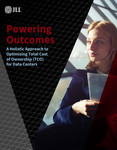In a 100 percent uptime-or-bust world, data center providers must supply unwavering reliability at the lowest possible cost. That’s a tall order for any data center operator. But with a strong handle on data, you can not only meet the dual challenge of delivering quality and efficiency – you can reduce the total cost of ownership (TCO) of your data center.
Easier said than done, right? Wrangling the mountains of data generated by critical environment facilities is notoriously difficult, let alone processing it to fuel business insight.
By investing in the right technology, processes, and people in order to power a data-driven approach to managing costs throughout the data center lifecycle, you can reap the benefits of lower TCO across your entire data center portfolio. Leveraging the TCO framework will enable you to understand the big picture, rein in unpredictable operating costs and uncover hidden expenses that so often reduce profitability.
Powering comprehensive cost analysis
How can data center operators drive down the costs of owning and operating an always-on facility? The holistic total cost of ownership framework considers all costs incurred during an asset’s lifecycle, from planning and design through to development, build, installation, commissioning, operations, maintenance, capital renewal and, finally, end-of-life decommissioning.
TCO considers not only the cost of acquiring and constructing a site, but also location factors – especially local energy prices – that affect operating costs. On the operations front, factors such as energy management strategies (power purchase agreements, renewable energy sources and so on) and reliability-centered, predictive maintenance, such as fault detection and diagnostics are critical for reducing operating and capital expenses over the lifespan of a facility.
However, accurately assessing both current and future project costs requires data – and the facilities technologies that generate the data. Multiplied across a portfolio, data and insights can power significant long-term savings and more predictable operating expenses for data center leaders – with the right human, technology and data reporting processes to support the endeavor.
Start with data and technology
The right technology stack is essential to capture the data needed to optimize TCO. In fact, an integrated technology stack can reduce data center operating costs by as much as seven-to-10 percent by streamlining workflow, extending equipment life and helping prevent failures.
For example, a data center-specific management solution like Fulcrum Collaborations’ Mission Critical Information Management (MCIM) platform generates real-time data about building systems. Automated work-order systems can also capture data about asset performance, critical incidents, and rounds.
Reliability-centered predictive maintenance uses performance and conditional data to guide repair decisions that ultimately increase ROI by extending asset lifespan. In addition, predictive maintenance reduces time spent on emergency repairs, freeing up facilities teams to prioritize uptime.
People power, strengthened by the power of data
To optimize TCO, you need to ensure your facility engineers have the right training and experience to generate, monitor and report on real-time performance data. Your on-the-ground team needs to understand how to use data in connection with a preventive maintenance strategy to make informed decisions that preserve intended function, extend equipment life and enhance operational performance.
Are your data centers primed for savings?
By embracing the power of data and proven processes in the TCO framework, you will undoubtedly see a dramatic and positive improvement in performance and a substantial increase in ROI. Not only will you make more informed in-the-moment decisions about operations and maintenance, but you’ll also maximize long-term savings.
These are all surefire ways to get your data center ahead of the competition.
To learn more about how to optimize TCO for data center operations, download the Powering Outcomes white paper.





